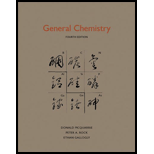
(a)
Interpretation:
The Lewis formula of
Concept Introduction:
Lewis Structure: A Lewis structure shows a covalent bond as pair of electrons shared between two atoms.
Procedure to write Lewis formulas:
- 1) The symbols of the atoms that are bonded together in the molecule next to one another are arranged.
- 2) The total number of valence electrons in the molecule is calculated by adding the number of valence electrons for all the atoms in the molecules. If the species is an ion, then the charge of ion into account by adding electrons, if it is a negative ion or subtracting electrons if it is a positive ion.
- 3) A two-electron covalent bond is represented by placing a line between the atoms, which are assumed to be bonded to each other.
- 4) The remaining valence electrons as lone pairs about each atom are arranged so that the octet rule is satisfied for each other.
Formal charge (F.C): The charges that assigned to each atom in a molecule or ion by a set of arbitrary rules and don not actually represent the actual charges on the atoms are called as formal charges.
The formal charge is calculated using the formula,
The Lewis structure with zero formal charge or least separated formal charges is the preferred structure of the molecule.
(a)
Explanation of Solution
The total number of valence electrons in
Number of valence electrons in hydrogen=
Number of valence electrons in oxygen=
Number of valence electrons in chlorine=
The total number of valence electrons is twenty-six.
One chlorine atom forms one bond with hydrogen and oxygen forms three bonds with that mean eight electrons are used to form that bonds and remaining eighteen electrons are used to satisfy the octet rule of oxygen atoms.
The Lewis formula is,
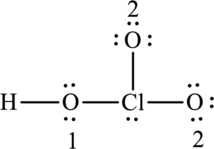
The formal charge for each atom is calculated as,
Formal charge on chlorine=
Formula charge on oxygen (1)=
Formula charge on oxygen (2)=
Formula charge on hydrogen=
The Lewis formula is,

A large charge separation can be seen in the structure, this can be avoided by adding two pi bonds between oxygen and chlorine. The chlorine atom can expand the octet rule since it belongs to period three. The final Lewis structure is,

(b)
Interpretation:
The Lewis formula of
Concept Introduction:
Refer to part (a).
(b)
Explanation of Solution
The total number of valence electrons in
Number of valence electrons in hydrogen=
Number of valence electrons in oxygen=
Number of valence electrons in nitrogen=
The total number of valence electrons is eighteen.
One nitrogen atom forms one bond with hydrogen and two bonds with oxygen that means six electrons are used to form that bonds and the remaining twelve are used to satisfy the octet rule of atoms.
The Lewis formula is,

The formal charge for each atom is calculated as,
Formal charge on nitrogen=
Formula charge on oxygen (1)=
Formula charge on oxygen (2)=
Formula charge on hydrogen=
The Lewis formula is,

A large charge separation can be seen in the structure, this can be avoided by adding one pi bond between oxygen and nitrogen. The final Lewis structure is,

(c)
Interpretation:
The Lewis formula of
Concept Introduction:
Refer to part (a).
(c)
Explanation of Solution
The total number of valence electrons in
Number of valence electrons in hydrogen=
Number of valence electrons in oxygen=
Number of valence electrons in iodine=
The total number of valence electrons is thirty-two.
One iodine atom forms one bond with hydrogen and four bonds with oxygen that means ten electrons are used to form that bonds and the remaining twenty-two are used to satisfy the octet rule of atoms.
The Lewis formula is,
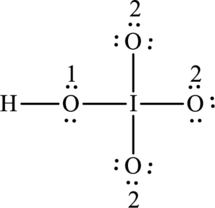
The formal charge for each atom is calculated as,
Formal charge on iodine=
Formula charge on oxygen (1)=
Formula charge on oxygen (2)=
Formula charge on hydrogen=
The Lewis formula is,
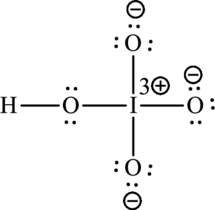
A large charge separation can be seen in the structure, this can be avoided by adding three pi bonds between oxygen and iodine. The iodine atom can expand the octet rule since it belongs to period five. The final Lewis structure is,
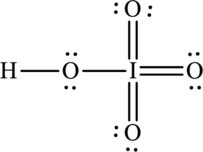
(d)
Interpretation:
The Lewis formula of
Concept Introduction:
Refer to part (a).
(d)
Explanation of Solution
The total number of valence electrons in
Number of valence electrons in hydrogen=
Number of valence electrons in oxygen=
Number of valence electrons in bromine=
The total number of valence electrons is twenty.
One bromine atom forms one bond with hydrogen and two bonds with oxygen that means six electrons are used to form that bonds and the remaining twelve are used to satisfy the octet rule of atoms.
The Lewis formula is,

The formal charge for each atom is calculated as,
Formal charge on bromine=
Formula charge on oxygen (1)=
Formula charge on oxygen (2)=
Formula charge on hydrogen=
The Lewis formula is,

A large charge separation can be seen in the structure, this can be avoided by adding one pi bonds between oxygen and bromine. The bromine atom can expand the octet rule since it belongs to period four. The final Lewis structure is,

Want to see more full solutions like this?
Chapter 7 Solutions
General Chemistry
- Please answer the question for the reactions, thank youarrow_forwardWhat is the product of the following reaction? Please include a detailed explanation of what is happening in this question. Include a drawing showing how the reagent is reacting with the catalyst to produce the correct product. The correct answer is IV.arrow_forwardPlease complete the reactions, thank youarrow_forward
- Consider the synthesis. What is compound Y? Please explain what is happening in this question. Provide a detailed explanation and a drawing to show how the compound Y creates the product. The correct answer is D.arrow_forwardWhat would be the major product of the following reaction? Please include a detailed explanation of what is happening in this question. Include steps and a drawing to show this reaction proceeds and how the final product is formed. The correct answer is B. I put answer D and I don't really understand what is going on in the question.arrow_forwardWhat is the product of the following reaction? Please explain what is happening in this question. Provide a detailed explanation and a drawing showing how the reagent is reacting with the catalysts to product the correct product. The correct answer is B.arrow_forward
- What is the missing intermediate 1 and the final product 2. Please include a detailed explanation explaining the steps of malonic ester synthesis. Please include drawings of the intermediate and how it occurs and how the final product is former.arrow_forwardWhat would be the reagents and conditions above and below the arrow that will complete the proposed acetoacetic ester synthesis? If it cannot be done efficiently, then I will choose that answer. There could be 2 or 4 reagents involved. Please provide a detailed explanation and drawings showing how it would proceed with the correct reagents.arrow_forwardFor benzene, the ∆H° of vaporization is 30.72 kJ/mol and the ∆S° of vaporization is 86.97 J/mol・K. At 1.00 atm and 228.0 K, what is the ∆G° of vaporization for benzene, in kJ/mol?arrow_forward
- The reaction Q(g) + R(g) → Z(l) is shown to be exothermic. Which of the following is true concerning the reaction. it is spontaneous only at High T, it is spontaneous at low T it is nonspontaneous at all T it is spontanrous at all T. it is non spontaneous only at low T.arrow_forwardThe reaction Q(g) + R(g) → Z(l) is shown to be exothermic. Which of the following is true concerning the reactionarrow_forwardWhich of the following has the largest standard molar entropy, S° (298.15 K) He H2 NaCl KBr Hgarrow_forward
 ChemistryChemistryISBN:9781305957404Author:Steven S. Zumdahl, Susan A. Zumdahl, Donald J. DeCostePublisher:Cengage Learning
ChemistryChemistryISBN:9781305957404Author:Steven S. Zumdahl, Susan A. Zumdahl, Donald J. DeCostePublisher:Cengage Learning ChemistryChemistryISBN:9781259911156Author:Raymond Chang Dr., Jason Overby ProfessorPublisher:McGraw-Hill Education
ChemistryChemistryISBN:9781259911156Author:Raymond Chang Dr., Jason Overby ProfessorPublisher:McGraw-Hill Education Principles of Instrumental AnalysisChemistryISBN:9781305577213Author:Douglas A. Skoog, F. James Holler, Stanley R. CrouchPublisher:Cengage Learning
Principles of Instrumental AnalysisChemistryISBN:9781305577213Author:Douglas A. Skoog, F. James Holler, Stanley R. CrouchPublisher:Cengage Learning Organic ChemistryChemistryISBN:9780078021558Author:Janice Gorzynski Smith Dr.Publisher:McGraw-Hill Education
Organic ChemistryChemistryISBN:9780078021558Author:Janice Gorzynski Smith Dr.Publisher:McGraw-Hill Education Chemistry: Principles and ReactionsChemistryISBN:9781305079373Author:William L. Masterton, Cecile N. HurleyPublisher:Cengage Learning
Chemistry: Principles and ReactionsChemistryISBN:9781305079373Author:William L. Masterton, Cecile N. HurleyPublisher:Cengage Learning Elementary Principles of Chemical Processes, Bind...ChemistryISBN:9781118431221Author:Richard M. Felder, Ronald W. Rousseau, Lisa G. BullardPublisher:WILEY
Elementary Principles of Chemical Processes, Bind...ChemistryISBN:9781118431221Author:Richard M. Felder, Ronald W. Rousseau, Lisa G. BullardPublisher:WILEY





